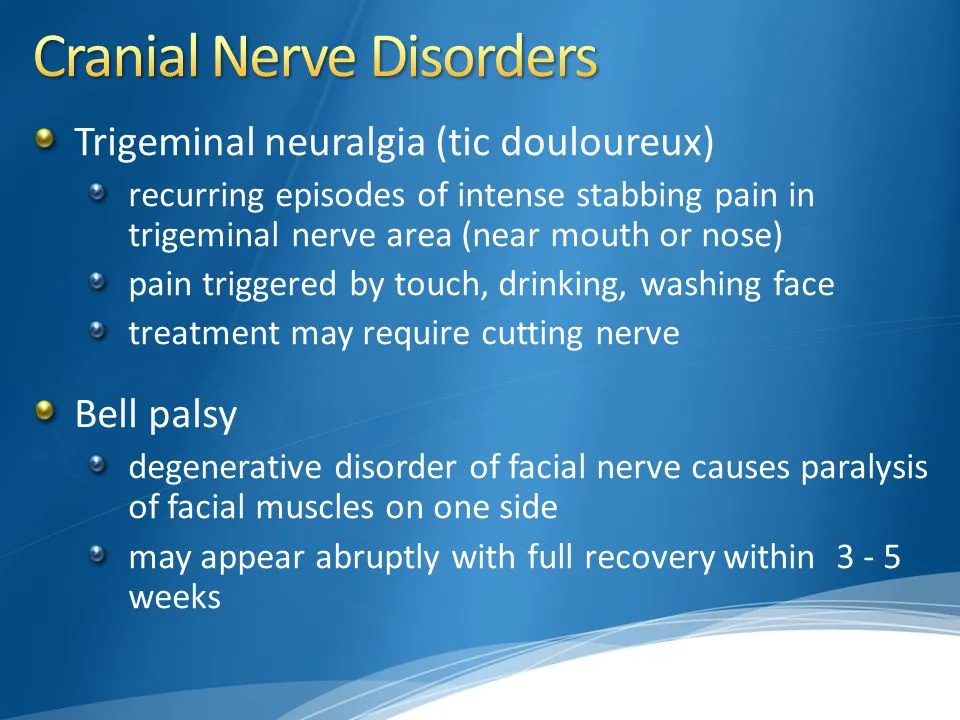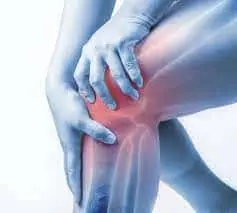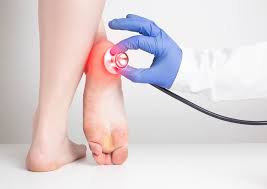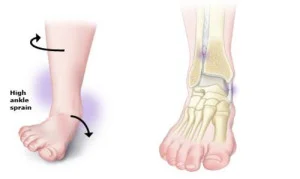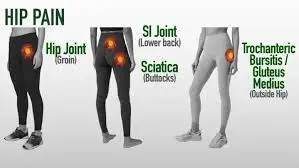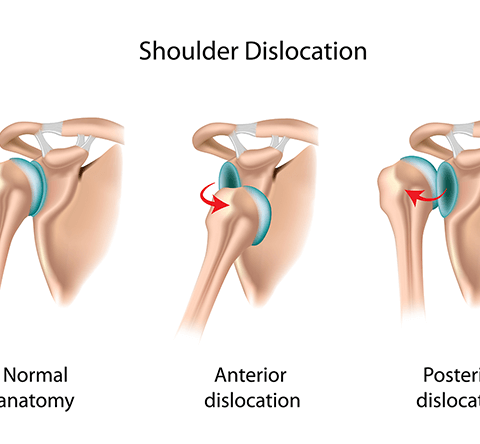Cranial Nerve Disorder
A Cranial Nerve Disorder is a dysfunction of one of the twelve cranial nerves, which originate at the base of the brain, travel via openings in the skull, and supply various areas of the head, neck, and trunk. These conditions can result in facial paralysis, tingling, numbness, weakness, or pain, including in the eyes.
The cranial nerves are the twelve nerves located behind your brain. They are connected to various parts of your face, neck, and torso, as well as your brain, and are essential to your ability to feel and move.
A dysfunction in one or more of these nerves that affects our capacity to move, feel, taste, smell, and/or hear is known as cranial nerve disease, or cranial neuropathy. This damage may have been brought on by an injury or an underlying medical condition like diabetes.
The patient’s specific type of cranial nerve issue will determine how they are treated. Certain forms of cranial neuropathies can heal on their own, while more severe ones may need to be surgically treated.
It could be necessary to treat and control certain infections, high blood pressure, or diabetes as well as other underlying illnesses initially. Lifestyle changes may also be necessary for management.
What are the cranial nerves?
Electrical impulses are sent from your brain to various areas of your neck, head, and torso by several cranial nerves. These cues assist with hearing, taste, smell, and facial muscular movement.
The back portion of your brain is where the cranial nerves start. They play a vital role in the neurological system.
What is the Number of Cranial Nerves?
There are twelve pairs of cranial nerves. Each pair of nerves divides to supply the left and right sides of your body and brain. You have one pair of olfactory nerves, for example, Your brain has two olfactory nerves: one on the left side and one on the right.
What are the types of Cranial Nerves?
Every one of your 12 cranial nerves has a specific function. Experts classify the cranial nerves according to their quantity and purpose:
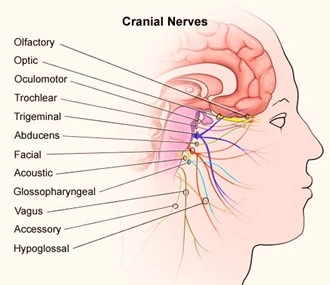
- Olfactory nerve: The sense of smell.
- Optical nerve: Visual ability.
- Oculomotor nerve: Eye movement and blinking ability.
- Trochlear nerve: The ability to move your eyes back and forth or up and down is provided by the trochlear nerve.
- Trigeminal nerve: Taste, motions of the jaw, and sensations in your face and cheeks.
- Abducens nerve: Eye movement ability.
- Facial nerve: Taste perception and facial expressions are examples of facial nerves.
- Auditory/vestibular nerve: Sense of balance and hearing is provided by the vestibular/auditory nerve.
- Glossopharyngeal nerve: The ability to taste and swallow is provided by the glossopharyngeal nerve.
- Vagus nerve: Heart rate and digestion.
- Accessory nerve (or spinal accessory nerve): The movement of the muscles in the neck and shoulders is the accessory nerve, also known as the spinal accessory nerve.
- Hypoglossal nerve: Tongue movement is controlled by the hypoglossal nerve.
Where do the Cranial Nerves originate?
- Your cerebrum serves as the origin of two of your cranial nerve pairs. The biggest part of your brain, located above your brainstem, is called the cerebrum. The following two sets of cranial nerves are:
- Olfactory nerves, control your sense of smell.
- Optic nerves that impact visual perception.
- Your brainstem is where the remaining ten pairs of cranial nerves begin. Your brain and spinal cord are joined by your brainstem.
What are the Functions of the Cranial Nerves?
- Your motor abilities and senses are influenced by your cranial nerves.
- Your senses allow you to: Feel touch, Hear, See, Smell, and Taste.
- Your facial muscles and glands are under the direction of your motor nerves. Certain cranial nerves are used for both motor and sensory purposes.
- The vagus nerve is the longest in the cranium. The vagus nerve is used for both motor and sensory purposes. It passes via the tongue, throat, heart, and digestive system, among other areas of your body.
Which Conditions and Diseases Impact Cranial Nerves?
The areas of the brain which include the cranial nerves might sustain damage from certain diseases or trauma. A disease may occasionally exclusively harm one cranial nerve. A nerve could be damaged or cut by trauma or surgery.
The following conditions affect the cranial nerves:
- Amyotrophic lateral sclerosis (ALS) is a degenerative disease that causes muscles to weaken and nerve cells to break down.
- Bell’s palsy: A sudden weakness in the muscles that causes one-half of the face to droop.
- Hemifacial spasm: Involuntary twitches or contractions on one side of the face.
- Internuclear ophthalmoplegia: Inability to move your eyes simultaneously in a sideways gaze.
- Oculomotor palsy: Damage to your third cranial nerve that results in one eye remaining positioned as though you are looking down and out to the side is known as oculomotor palsy.
- Stroke: When a blood clot or burst blood vessel interrupts the flow of blood to the brain, the system is affected.
- Traumatic brain injury: A quick, powerful blow to the head that causes disturbance or impairment to brain function.
- Trigeminal neuralgia: Persistent pain in your cheek caused by the fifth cranial nerve.
What are the Symptoms of the Cranial Nerve Disorder?
Depending on which cranial nerve is injured, different cranial nerve disorders will cause different symptoms. Typical symptoms include the following:
- Pain
- Tingling
- Numbness
- Deficiency(weakness)
- Immobility
- issues with vision
- loss of hearing
- Having trouble swallowing
- Having trouble speaking
- To get a diagnosis and treatment for any cranial nerve disorders you may have, it’s critical to visit a physician. Early detection and intervention can help stop more nerve injury.
How Can be Disorders of the Cranial Nerve Diagnosed?
The doctor would start a thorough consultation by getting more information about your problem by asking the following questions: Among them could be:
- An extensive medical history, both personal and family
- onset of the symptoms
- symptoms that are specific to your way of life
- For a precise diagnosis, we would often perform a physical examination and order certain tests.
Magnetic Resonance Imaging (MRI) examination
- High-energy magnetic pulses and radio waves are used in MRI machines to create detailed images. To rule out the etiology of neuropathy and related tumors, for instance, a higher resolution MRI with contrast and other specific sequences (CIS) is frequently used to clarify lower cranial nerves and their interaction with vascular structures.
Electromyography(EMG)/Nerve Conduction Velocity (NCV) test
- It is a technique in which a needle is inserted into the muscle to measure electrical activity. Important techniques for the functional evaluation of nerve fibers and their innervation include NCV and EMG studies.
Audiometry
- Your ability to hear is assessed by a painless method called audiometry, which involves exposing you to various frequencies in a controlled environment. This aids in the diagnosis of acoustic tumors.
What is the treatment for disorders of the cranial nerve?
The type, severity, and location of the nerve problem all influence how it is treated
Medical treatments
- Medication is a successful treatment for a few conditions:
- Phenytoin or carbamazepine are the medications used to treat trigeminal neuralgia.
- Steroid medications are used to treat Bell’s palsy.
- Diabetes-related third nerve palsy, also known as oculomotor nerve palsy, is treatable medically.
Rehabilitation
A damaged nerve might eventually heal. Rehabilitation may be useful in certain situations to help you regain your nerve function. Professionals who can provide rehabilitation aid to you include:
- For auditory nerves, an audiologist.
- For nerves that regulate balance or motor function, see a physical or occupational therapist (such as vestibular rehabilitation).
- Speech-language pathologist for nerves in the mouth and face.
- Vision therapist for nerves in the eyes.
Surgical Treatment
Microvascular decompression procedures
- To relieve pressure and treat trigeminal neuralgia symptoms, a minimally invasive (keyhole) procedure is used to create a cushion between the cranial nerve and the vessel. Behind the ear, a tiny keyhole incision is made. To reduce nerve discomfort, tiny Teflon pads are put between the nerve and the vessel using advanced imaging technology and an endoscope or microscope. As an alternative, targeted radiation doses can be applied to the nerve’s root entry during gamma knife surgery, also known as radiosurgery, to reduce pain.
Surgical removal of tumors that surround the cranium nerve
- There are instances where a minimally invasive endoscopic or microscopic procedure is used to remove the tumor enclosed in the cranial nerve sheath. Given the closeness of the neurovascular structures, this requires a high level of skill on the part of the neurosurgeon. Another treatment option for small tumors (less than 2.5 cm) is gamma knife radiosurgery.
How can maintain the health of Cranial Nerves?
A few simple lifestyle adjustments can help maintain the health of your nervous system, including your brain and cranial nerves. You could:
- Reach and keep a healthy weight for your age, sex, and body type.
- Only use alcohol sparingly.
- Eat a diet high in fruits, vegetables, whole grains, and other foods that are high in nutrients.
- Engage in regular exercise.
- Maintain a healthy blood pressure range.
- Handle any illnesses, such as diabetes, that raise the chance of nerve injury.
- Give up smoking.
Summary
Cranial Nerve Disorder can cause severe symptoms such as dysphagia, intense pain, and other symptoms. Do not hesitate to see your neurosurgeon if you experience any signs of a cranial nerve issue because prompt diagnosis results in prompt treatment. They will collaborate with you to successfully manage these symptoms or perform surgery.
FAQs
What is The Cranial Nerve Disorder?
A cranial nerve disorder is a dysfunction of one of the twelve cranial nerves, which originate at the base of the brain, travel via openings in the skin, and supply various areas of the head, neck, and trunk. These conditions can result in facial paralysis, tingling, numbness, weakness, or pain, including in the eyes.
Which cranial nerve conditions are there?
Bell’s palsy is one of the various forms of cranial neuropathies. Affected facial nerves (the seventh cranial nerve) give rise to this disorder.
Microvascular palsy of the cranial nerve. The nerves in the eye are impacted by this disorder.
Three-nerve palsy.
Fourth nerve palsy.
sixth nerve palsy.
What signs indicate damage to a cranial nerve?
Symptoms of cranial nerve disorders might include severe pain, dizziness, loss of hearing, weakness, or paralysis. Smell, taste, pronunciation, facial expression, swallowing, and neck muscles can all be impacted by these illnesses.
Will cranial nerves recover?
While complete cranial nerve lesions are significantly less likely to heal, incomplete lesions frequently do over time. Particularly when combined with occupational therapy and olfactory training, the olfactory nerve can regenerate and heal.
Which cranial nerve is most frequently injured?
Facial nerve injury is the most typical cranial nerve damage seen secondary to birth trauma.
References
- Cranial Nerve Disorders |. (2022, November 11). https://brainandspine.sg/cranial-nerve-disorders/
- Professional, C. C. M. (n.d.-d). Cranial nerves. Cleveland Clinic. https://my.clevelandclinic.org/health/body/21998-cranial-nerves
- Multiple cranial neuropathies. (2020, August 31). Johns Hopkins Medicine. https://www.hopkinsmedicine.org/health/conditions-and-diseases/multiple-cranial-neuropathies
- Cranial Nerve Disorders | UPMC | Pittsburgh, PA. (n.d.). UPMC | Life Changing Medicine. https://www.upmc.com/services/neurosurgery/brain/conditions/cranial-nerve-disorders
- Moini, J., & Piran, P. (2020). Cranial nerves. In Elsevier eBooks (pp. 319–344). https://doi.org/10.1016/b978-0-12-817424-1.00010-0

